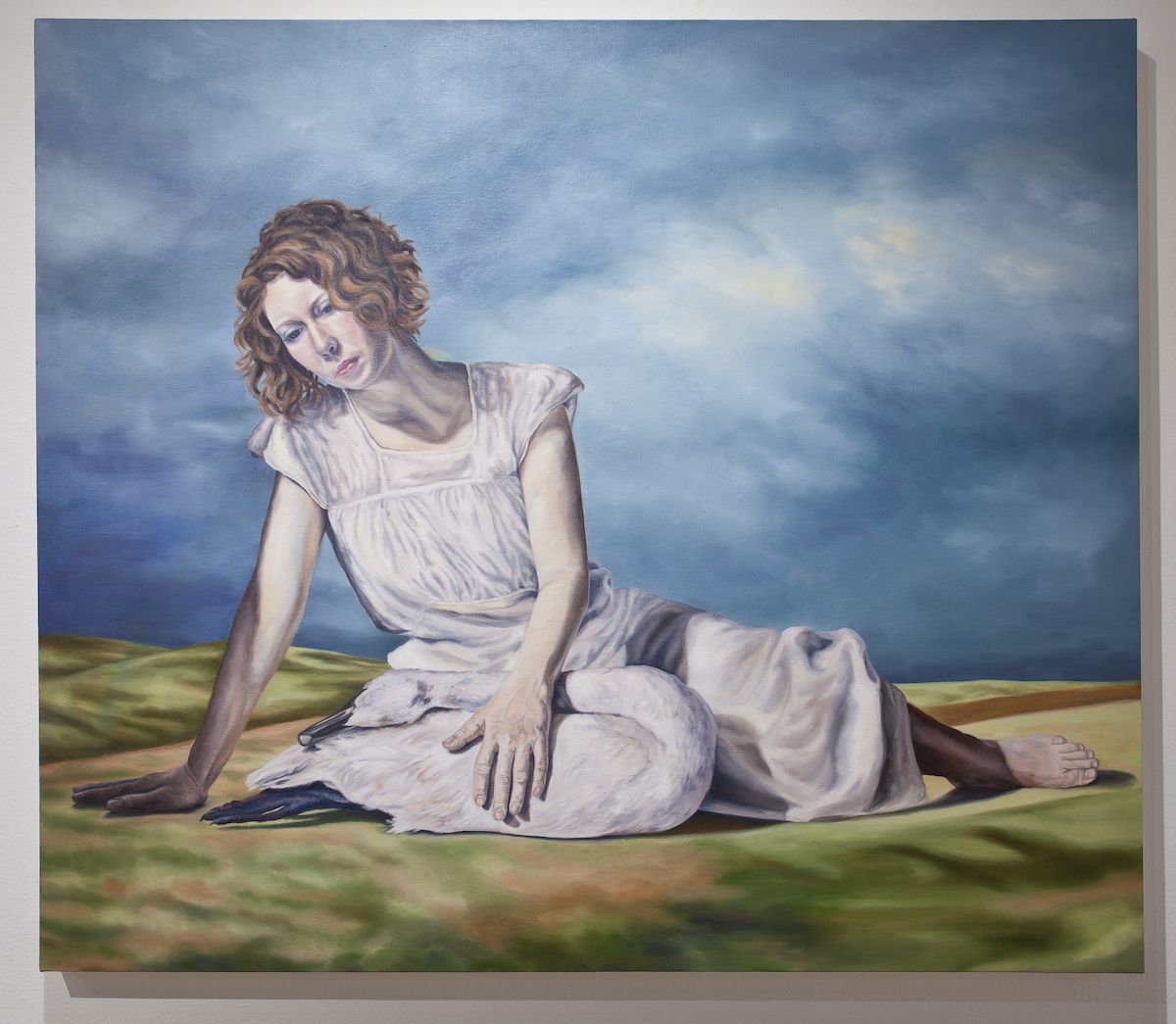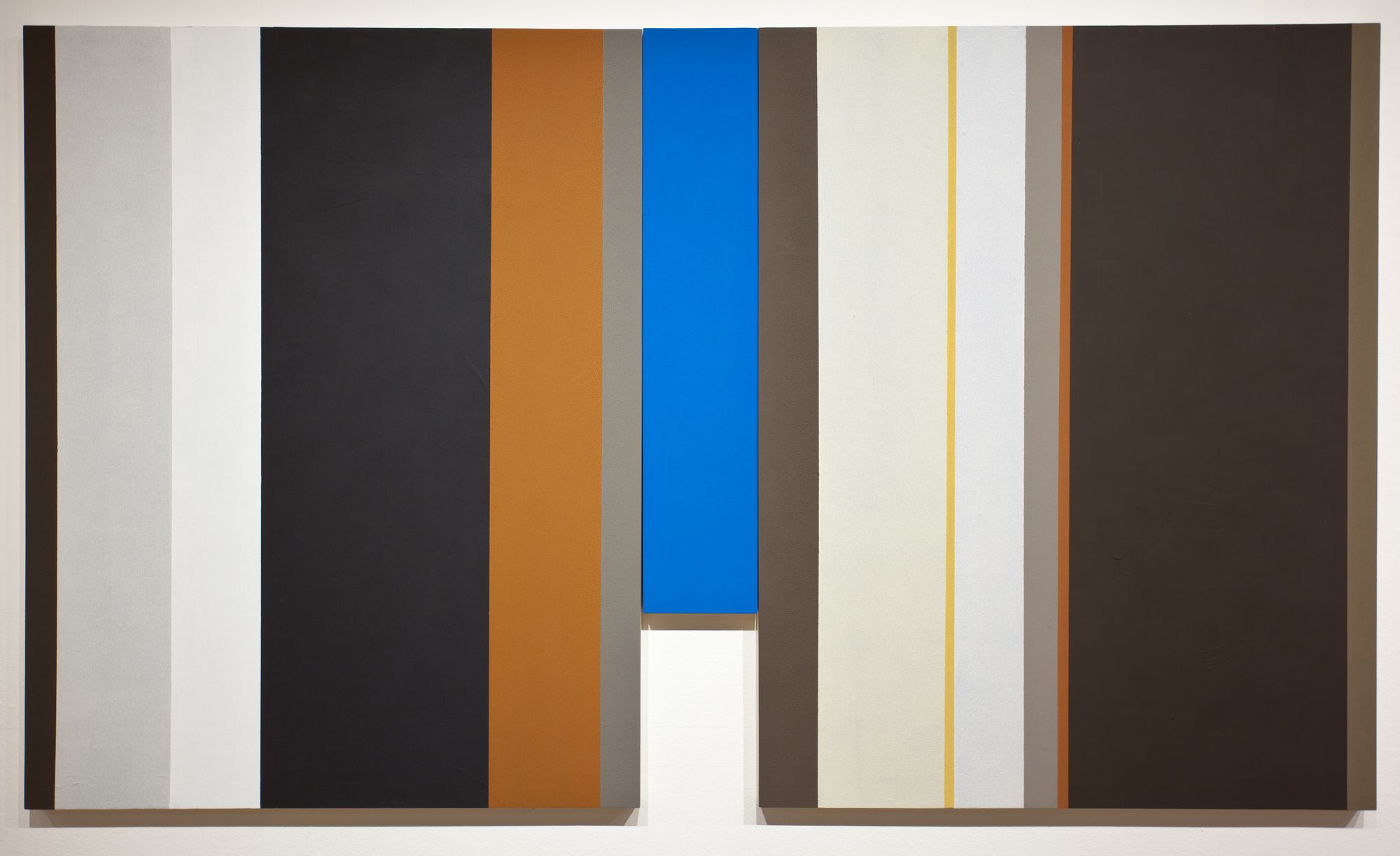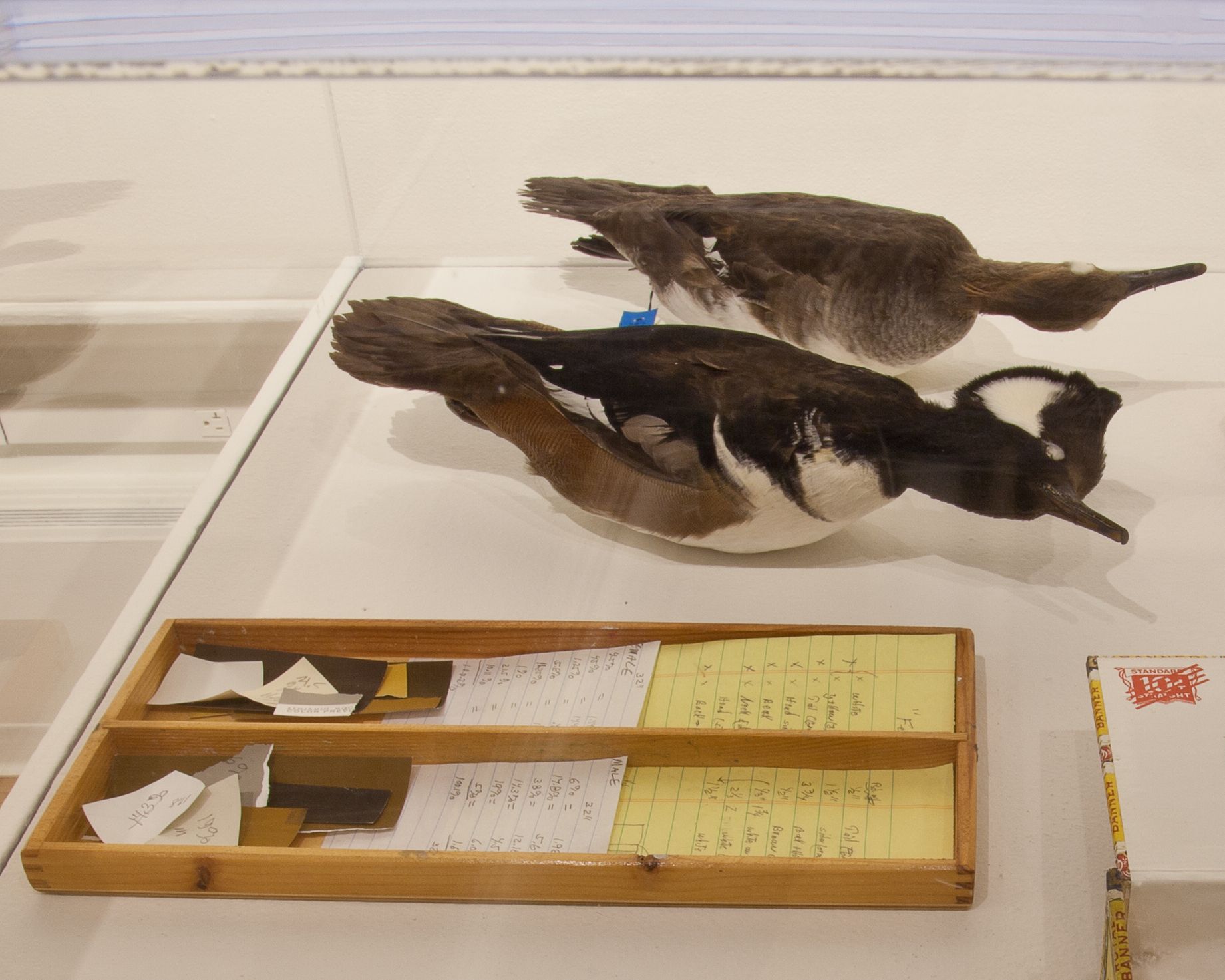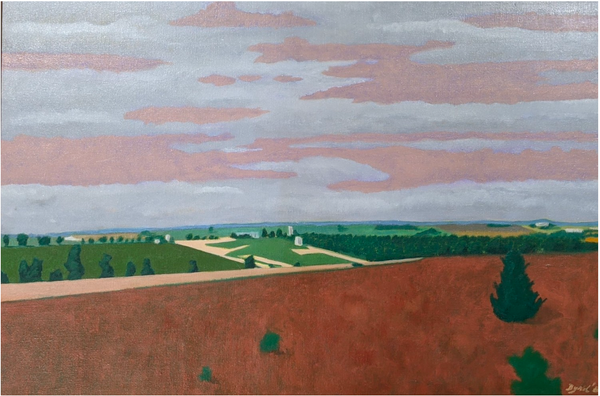Re-Presenting Nature: Picturing the Truth
by Carol Emmons and Daniel J. Meinhardt
Preface
There is often a tendency to see science and art as opposed: one rational and quantified and the other emotional and intuitive. This view succumbs to the stereotypes of each and does them both a disservice. What we are attempting here, as artist and scientist, is to look more closely at the workings of both approaches—and looking closely is just one commonality we share.
In 2018 one of us (DJM) became curator of the Richter Museum of Natural History at UW- Green Bay. To increase public awareness of this little-known gem he solicited artists to tour the museum and use the collections to inspire new work, which would be exhibited at the university’s Lawton Gallery in fall 2019. Twenty-six artists completed work for the show, which was called Museum of Natural Inspiration and contained well over 50 individual pieces (some of which were exhibited at the Artless Bastard in De Pere).
An Artist Looks (Carol Emmons)
How do we come to understand the world? Certainly through direct experience, but also through representation: that is, re-presenting what we see. There are innumerable means of doing this, but visual representation may be among the earliest methods used by humans to articulate their world.
How does this work? There is a spectrum of possibilities, ranging from the representational (or objective or illusionistic)—art which seems to show the world as it appears—to non-representational (or non-objective) art at the other extreme: art which seems to owe nothing to the world. True abstraction falls in between: it borrows from the world (“abstract” means “draw away”), but alters or exaggerates formal aspects like shape (in Cubism) or color (Fauvism), with the subject maintaining various degrees of recognizability.
The first approaches are primarily perceptual (about how things look), while the latter two become more conceptual, addressing the idea of things rather than their surface appearances. Similarly, the first are often thought of as objective and the latter as more subjective, emphasizing the experience more than the appearance.
Thus, classic European modernism utilizes abstraction to emphasize certain aspects of the world: Monet’s Impressionism is often about the effects of light, while Cubism investigates knowing a thing through multiple views. The intent was not to replicate the superficial look of the world but to reveal its truths, with abstraction a means toward this, and often part of a search for a universal language.
Kendra Bulgrin’s work certainly falls on the illusionistic end of the spectrum: we have no difficulty identifying the subject matter as swan and woman, both painted with proportional accuracy. But if we look closely, we can see that she takes some liberties in the creation of her image. Most obviously, the landscape here is abstracted and perhaps invented—it is more a “non-place” than a particular site. This contributes to a slight—perhaps unconscious—sense of disquiet.
Similarly, the strong light on the main figure contradicts the overcast sky, adding to the vaguely surreal atmosphere. Likewise, the woman is rendered with a sharply defined approach (seen especially in the repeated lines of hair, hands, and fabric) which also contrasts the undulating landscape. At the same time, the swan is more painterly (has noticeable brushstrokes and softer edges). So what might at first appear to be a purely objective painting actually embodies multiple approaches to representation. The combination of the subject matter and modes of representation leads to a more subjective painting, and by extension, one more open to interpretation.


How might we make sense of this painting? As above, one approach is to start with what we see. We might notice the extent to which the woman and the swan are merged: the swan and the dress are the same color, the feathers resemble the folds of the dress, and the organic shapes in the bird repeat those of the human figure. In fact, the right side of swan echoes the drapery falling over the woman’s leg. Theeffect is that the bird is almost camouflaged by or integrated into the woman. This further challenges what would seem to be a straightforward rendering of reality.
We could go on for some time considering Bulgrin’s choices in this way, yet to look only at these formal elements does not tell the whole story. One approach to enhance our understanding of the work is to consider context. In this case, we might be reminded of Leda and the swan, Swan Lake, or The Ugly Duckling. We could consider “swan song,” or that swans generally mate for life, and contemplate how these might apply.
Another approach in building our interpretation is to make use of the title. Who is the ‘you’ referred to here, and who is the ‘I’? The accusatory tone of the question is at odds with the dreamy quality of the painting, and creates additional tension.
We can’t know for certain which—if any—of these references the artist may have considered, but that isn’t ultimately essential. Rather, in looking at the visual forms and the context, and reflecting on our own feelings, we begin to arrive at potential meanings. That we are likely to come to differing conclusions is not a failing of the work, but rather the inherent magic of art: one can repeatedly find new meanings and new ways of seeing the world.
A Scientist Looks (Daniel Meinhardt)
Before any artists accepted my offer to tour the museum I was concerned that the project would attract representational workers almost exclusively. I had been part of shows that featured scientific illustration (one of my professional interests) and know that natural history imagery is dominated by work such as Elizabeth Gould’s and John James Audubon’s exquisitely detailed bird paintings, which were intended primarily to aid in the identification of the species being rendered.
My goal for this show was to expand awareness of the museum beyond its typical users and patrons, and I would rely on Lawton Curator Emma Hitzman to help select work that would appeal to the gallery’s audience. However, I was responsible for getting the right group of artists into the museum in the first place, and I wasn’t sure I could pull it off.
One of the first artists to visit the museum was Marjorie Mau, and when I mentioned my interest in including non-representational pieces in the show her eyes lit up as she assured me hers would most definitely be an abstraction. And wow, is it abstract! In fact, Deconstruction by Color and Gender can be considered a lesson in abstraction, while at the same time it dismantles the apparent contradictions between abstract and representational, between perceptual and conceptual, and between two of my main interests, art and science.
A review of her methods shows the piece to be precisely quantitative, while at the same time obviously abstract in that it looks nothing like the birds on which it is based. It is a huge departure from the near photographic work of Audubon, though it employs a level of scientific precision that might exceed that of his nineteenth century illustrations. During the show it was no surprise to see my science colleagues drawn to the piece as we deal almost exclusively with the world through quantification.
An avid observer of nature, Mau borrowed two specimens of hooded mergansers, one male and one female, to use as inspiration for her piece. In collaboration with her husband Dave, a retired civil engineer, she identified each color and measured the surface area covered by each on both specimens. Like many birds, hooded mergansers are sexually dimorphic, meaning the males and females differ in outward appearance. Thus, the male and female can be distinguished by their different color patterns. However, Mau’s painting removes all trace of the birds’ patterns, leaving only the proportions revealed by her objective measurements. This objectivity is conveyed in the sharp separation between, and uniformity within, each represented color. Though her paints are an interesting mix of marble dust, wax, and pigment, Mau's hand is not obvious within the almost graphical nature of her application.


One reason I am drawn to the painting is because of how it challenges categorization. It’s not obviously representational but it represents. It represents sex. It represents appearance (in color proportions if not in pattern). It even represents explicitly our role in categorizing by including a large blue panel representing the museum tags used to label the specimens. The panel separates the two birds much as we do when giving each a different number and entry in a database.
The painting is perceptual in its recreation of the colors one sees when viewing the birds. Color exists ONLY as a perception, a retina-dependent categorization of wavelengths of light. It is conceptual in Mau’s choices of what to represent (e.g., sex, color proportions, but not color patterns). Like a scientist, Mau measured objectively, even collaborating with someone trained in quantitative techniques. Also like a scientist, her choices of what to measure were guided by the concepts in which she is interested.
The same can be said of a scientific illustrator, whom we could wrongly assume attempts to remove themselves entirely from the process. In fact, scientific illustration still exists because scientists need it to communicate a conceptualized understanding of nature. The best field guides use illustrations, not photographs, because they are intended to help users recognize a species’ gestalt, not any one individual. In a single illustration all the detail a scientist needs conveyed can be presented in a single organism, even if that organism only exists as an amalgam of the larger thing we call a species.
Conclusion
So here is the conundrum regarding these two works: we have an abstraction which is highly objective, and relates specific, quantitative information about merganser ducks, while our representational work is arguably more subjective, and its meaning more fugitive. Bulgrin’s work is built upon the trace of the artist’s hand, while Mau’s painting manifests its materiality with an uninflected surface; the former is an illusionistic image while the latter functions more as object.
Do either of these works tell the truth? A popular view is that veracity resides exclusively in representational art, in works that resemble nature. Yet a commonality of artists and scientists is that both are interested in expressing truths, whether about the external world or internal human feeling. Ideally, the individual scientist ignores the latter, but knows an objective understanding of the former comes only through the communal, adversarial process of peer review. Perhaps the answer is that cumulatively, the approaches of these artists capture a larger truth—one that is not always concrete but conceivably more nuanced. Ultimately, both science and art can be seen as a reciprocal process of illumination, continually moving between what we think we know and what is yet to be discovered.
For more information, please see:
Museum of Natural Inspiration exhibition: https://meinhardtphoto.smugmug.com/Museum-Nat-Insp/ and https://www.flickr.com/photos/lawtongallery/albums/72157712261240741 Richter Museum of Natural History: https://www.uwgb.edu/richter-museum/ Kendra Bulgrin: http://www.kendrabulgrin.com/
Marjorie Mau: https://www.marjoriemaustudio.com/
Daniel J. Meinhardt: https://meinhardtphoto.smugmug.com
Carol Emmons: https://www.carolemmons.net/
Carol Emmons is an installation artist and Professor Emerita of Art at the University of Wisconsin-Green Bay. Her work for The Museum of Natural Inspiration was Cosmogony 2.4: The Cosmic Egg, a mixed- media installation conflating global origin stories featuring eggs and Carl Richter’s egg collecting notebooks.
Daniel Meinhardt is Associate Professor of Human Biology and Curator of the Richter Museum of Natural History at the University of Wisconsin-Green Bay. His graduate degree is in ecology and evolutionary biology, but he also received training in scientific illustration. Over the last ten years his work has centered on the role of imagery in understanding biological issues such as sex, gender, and biodiversity.



